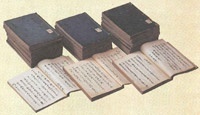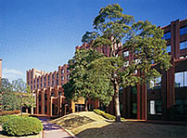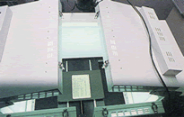Ryukoku University You, Unlimited
Need Help?
About
History
The Spirit of Tradition and Innovation Embodied in the 370 Year History of Ryukoku
Ryukoku University was established as a Buddhist seminary called “Gakuryo” (Boarding School) in the precincts of Nishi-Hongwanji Temple by its 13th abbot, Ryonyo, for the promotion of research and Shin Buddhism education. Being older than Shoheiko, the official Edo Shogunate school, Ryukoku is one of the oldest institutions of higher education in Japan.
| 1639 | Started its history as a Buddhist institution of higher education |
|---|---|
| 1640 | Teaching started. The first school master was a Buddhist priest, Jungen. |
| 1655 | Destruction of Gakuryo by an order of Shogunate government. However the seminary continued to exist under a different name, Gakurin (Learners’ Forest). |
| 1788 | Burned down in a great city fire. |
| 1792 | Reconstruction of the Gakurin lecture hall Gakurinbanken Gakurinbanken (Comprehensive Inspection of Gakurin) is a transitional record of the curricula, regulations, systems, students’ lives and daily events in the seminary between 1807 and 1871. This is the basic record to understand Gakurin in the late pre-modern period. |
|---|---|
| 1872 | A Western subject (German) taught for the first time. |
| 1879 | Establishment of Daikyoko, Great School, (the main hall, north & south dormitory and main gate on the present Omiya campus) Daigakurin (Great Gakurin, i.e. the present Omiya campus) seen on the left side of the painting was originally a newly built hall for Daikyoko (Great School) established in September, 1876, as the highest institution of the educational system promulgated by the Nishi-Hongwanji organization. The present main hall, and north and south classroom buildings were the then lecture hall and dormitories, supposedly modeled after college architecture in Oxford and Cambridge. The main hall, north & south classroom buildings, old guardian house and main gate are designated as important cultural assets of Japan. |
| 1880 |  The chair that the Emperor Meiji used on this occasion may be seen on the first floor of the main hall in the Omiya campus. The chair is on casters and its back, legs and armrests are decorated with turtle shells. |
| 1887 | Published Japan’s first general magazine Reflection Association Magazine Some of the students on the regular course organized a group called “Reflection Association” to promote social reform movements such as temperance. In 1899, their “Reflection Association Magazine” was renamed “Chuo-Koron”, the first general magazine in Japan, and developed into one of the most widely circulated intellectual monthly journals of the country. |
|---|---|
| 1900 | Three tier educational system established: Buddhist College, Buddhist high school and Buddhist middle school. |
| 1903 | Otani Expedition’s excavation of Kumtura Thousand Buddha Caves in Kucha (Xinjiang Uighur Autonomous Region). The “Otani Expedition” was an exploration party that Otani Kozui, the 22nd abbot of the Nishi-Hongwanji Temple, dispatched three times to Central Asia to carry out field investigations into the expansion process of Buddhism from India towards the east. The research materials brought back by the expedition are held in Omiya Library as “Cultural materials of the West collected by the Otani Expedition.” |
| 1905 | Officially approved as Bukkyo Daigaku (Buddhist College) under Professional School Order (enacted in 1903). |
|---|---|
| 1909 | The Otani Expedition At Loulan the Otani expedition excavated and collected the “Libai Document” (Draft of Lihaku’s letter, Chinese Li bai chi du gao, Japanese Lihaku-sekitoku-ko). This is valuable historical material of the period when paper began to become widely used and is now designated an important national cultural asset. |
| 1922 | Renamed Ryukoku University Became a university under University Ordinance |
| 1928 | Accepted female students for the first time |
| 1936 | Establishment of Omiya library As a commemorative project, construction of a new library was decided on, to accommodate the increased numbers of books and students. Nishi-Hongwanji, the university and alumni worked together to raise the funds necessary for the project. |
|---|---|
| 1939 | Published “300 Year Chronicle of Ryukoku University” |
| 1953 | Received the donation from Nishi-Hongwanji of Buddhist scriptures and ancient documents that the Otani Expedition collected |
| 1958 | Official Visit of the first Indian president.Granted honorary doctorate to the president While staying in Japan as a state guest, President Prasad, the first president of India, visited Ryukoku University and received the first honorary doctorate from the then university president, Masuyama. |
| 1960 | Fukakusa Campus established as a commemorative project of the 700th anniversary of Shinran Shonin Fukakusa campus was established on the site of an American military base in Kyoto. Its facilities were used as classrooms and administrative offices as they were. Students were surprised how bleak the campus was and allegedly lamented, “Why was this area named “Deeply Grassed” (Fukakusa)? There is not one blade of grass here at all!” |
| 1963 | Built the 1st Hall, the oldest surviving building on Fukakusa Campus. |
|---|---|
| 1964 | Main hall, main gate, etc. on Omiya Campus designated important cultural assets |
| 1965 | Relocation of Junior College to Fukakusa Campus due to the increase of students. Some faculty members were allegedly against leaving the familiar Omiya Campus. |
| 1968 | Won the Kansai Six University League Baseball Championship for the first time |
| 1969 | Campus revolts occurred and Fukakusa Campus was blockaded for 50 days. Demonstrators wearing helmets stormed the graduation ceremony, shouting, “Destroy the graduation ceremony!” and professors strove to stop them. |
| 1972 | Off-campus free legal counseling service by the Faculty of Law started |
| 1973 | Celebrated its 330th anniversary. Fukakusa campus library completed. |
| 1979 | The Shieikan, research and administration building, completed The Shieikan, completed as a part of the Fukakusa campus expansion. Its brick design was used in future buildings. |
|---|---|
| 1981 | One of the 3000 camphor trees planted in the “peace forest” surrounding the site of the Atomic Dome in Hiroshima was replanted on the Fukakusa campus. |
| 1984 | Buddhist chapel "Kenshinkan" completed |
| 1987 | Obtained the land for the construction of the Seta campus. International symposium co-hosted by Ryukoku University and Harvard University on their 350th Anniversaries. |
| 1989 | Seta campus opened. At first it consisted of just Building 1, the Gym, Library and Seishikan cafeteria. |
| 1991 | The Ryukoku Extension Centre (REC) opened on the Seta campus aimed on strengthening research-industry ties and providing community-focused education. |
| 1994 | Created “Rental Laboratories” in the REC hall, a first in Japan. |
|---|---|
| 1997 | Competed construction of Building 21, the approximately 30m tall main entrance building of the Fukakusa campus. The main gate's design is the same as that of the Omiya Campus, an important cultural asset. The building's name refers to the desire for the university to soar into the 21st century. |
| 2000 | Published “The 350 Year History of Ryukoku University”. |
| 2001 | Opened the Digital Archive Center. Aimed at recording high-resolution digital images of the historical documents in the university’s possession as well as national treasures or important cultural assets, the center preserves, organizes and orders the images before making them available to the public via the Internet, etc. The center received the Digital Archive Award in 2003. A machine capable of recording high-resolution digital images that fully capture the original documents. |
| 2004 | Completed construction of the multi-purpose Seta Dome indoor practice ground and Student Association Hall on the Seta campus. |
| 2005 | Opened the Ryukoku Office in Tokyo’s Marunouchi business district. |
|---|---|
| 2006 | Opened the Ryukoku University Berkeley Center (RUBeC), California, USA. |
| 2009 | The University celebrates the 370th anniversary of its founding. The Graduate School of Practical Shin Buddhist Studies(Master's Degree Program)is established. |
| 2010 | Long-Term Plan V is initiated. |
| 2011 | The Faculty of Policy Science, Department of Policy Science and the Graduate School of Policy Science, Department of Policy Science (Master's and Doctoral Degree Programs) are established. The Junior College, Department of Childhood Care and Education is established. The Ryukoku Museum opens. |
| 2012 | The Faculty of Letters, Department of Clinical Psychology is established. The Graduate School of Letters Department of Clinical Psychology(Master's and Doctoral Degree Programs)is established. |
| 2013 | Industrial Corporation, Ryukoku Merci Co., Ltd is established with 100% capital investment from Educational Corporation, Ryukoku University. Fukakusa Machiya Campus is established.Social-contributing mega solar power plant, Ryukoku Solar Park is installed. |
| 2015 | Faculty of Intercultural Communication is reorganized as Faculty of International Studies and relocated to Fukakusa Campus. Faculty of Agriculture is established. Research Center for World Buddhist Cultures is established. |
| 2016 | The Faculty of Letters, Department of History, Cultural Heritage Course is established. The Faculty of Sociology , Department of Contemporary Social Work is established. |
| 2018 | The Graduate School of Agriculture, Department of Food and Agriculture Science (Masters and Doctoral programs) are established. |
| 2019 | The University celebrates the 380th anniversary of its founding. The Graduate School of Intercultural Communication is reorganized as the Graduate School of International Studies. |
| 2020 | Faculty of Science and Technology reorganized as Faculty of Advanced Science and Technology. Ryukoku Strategic Plan 400 initiated. |